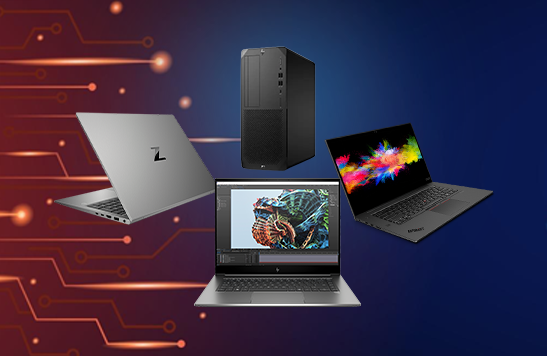

A workstation is a high-performance computing device that has been purpose built for demanding professional workflows. It is not a single form factor in the same way that a desktop or notebook is – it can take almost any form factor. If mobility and agility are the most important factors for the device you need, you might choose a notebook, but if you need performance tuned to a specific workflow, a workstation will always be the best option. Workstations are designed for professional workflows and are more powerful than a general PC. For example, a data scientist, visual effects professional, engineer or software developer all have different needs in terms of data processing, performance, operating systems, keyboard shortcuts, storage, display and connectivity. They are built for managing those high intensity but diverse workflows. The technology that makes that possible is not always immediately obvious when looking at devices. Some vendors use copper and other software in their products to completely redesign the efficiency of the thermals in mobile workstations. That includes giving users complete control over the type of performance and acoustics for specific workflows, with artificial intelligence often called in to intelligently manage behavior based on the type of work being done. The best workstations can handle any application you throw at it, and they are useful tools for designers, engineers, financial analysts and researchers running more demanding applications, like rendering complex graphics, financial analysis and computations and digital content creation
You surely want the best workstation that you or your company can afford. Some of the things you’ll be looking for is a workstation that:
Helps you design efficiently.
Has enough memory and storage to manage the large files you produce.
Comes with a large display so you can better view your designs.
To do this, you must consider details like the:
GPU: As opposed to a CPU (central processing unit) which people call the “brain” of a computer. A GPU (graphics processing unit) enhances the “brain.” This is a single-chip processor that manages and boosts the performance of video and graphics. It renders the graphics to the monitor.
Processor: A processor is an electronic circuit that performs arithmetical, logical, input/output (I/O) and other basic instructions that are passed on to the operating system (OS) that runs the computer.
Memory: Cache memory provides high-speed data access to a processor. It also stores frequently used applications, data and computer programs. It’s embedded in the processor (or Random Access Memory-RAM) and is the fastest type of memory in a computer.
Hard Drive: The is the main, and usually the largest, data storage device in a computer.
Monitor: This is the electronic computer display that includes a screen, circuitry and case. Older monitors used cathode ray tubes (CRT). This made them large and heavy. Today, we use LCD (Liquid Crystal Display) flat-screen monitors because they’re more energy efficient and much lighter.
The Apple iMac Pro is a great machine, but like the Surface Studio from Microsoft, some believe it’s overpriced. However, with the quality of the internal components it provides, you may decide that the price is worth paying.
Some graphic designers prefer to go with the Apple iMac with 4K Retina Display. As a matter of fact, many graphic designers won’t use anything other than a Mac. This is due to the quality that Apple has been building into their products for so many years. Graphic designers have been Apple’s biggest fans since they first started making computers.
Hewlett Packard all-in-one Envy 34 is a quality workstation for your graphic design needs.
This is a computer tower without a monitor attached. If you like selecting your own high-end monitor, this can be a good choice for you. But, if you want an all-in-one desktop computer, then this option won’t work for you.
Aliqu justo et labore at eirmod justo sea erat diam dolor diam vero kasd
© Your Site Name. All Rights Reserved. Design by HTML Codex